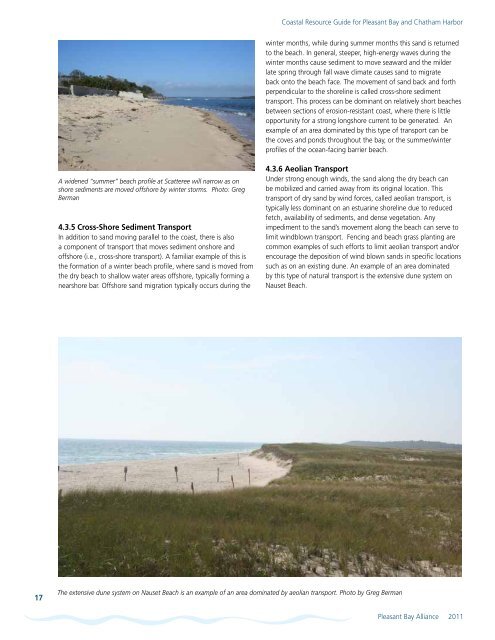Coastal Resource Guide Pleasant Bay and Chatham Harbor
Coastal Resource Guide Pleasant Bay and ... - Town to Chatham
Coastal Resource Guide Pleasant Bay and ... - Town to Chatham
Create successful ePaper yourself
Turn your PDF publications into a flip-book with our unique Google optimized e-Paper software.
<strong>Coastal</strong> <strong>Resource</strong> <strong>Guide</strong> for <strong>Pleasant</strong> <strong>Bay</strong> <strong>and</strong> <strong>Chatham</strong> <strong>Harbor</strong><br />
winter months, while during summer months this s<strong>and</strong> is returned<br />
to the beach. In general, steeper, high-energy waves during the<br />
winter months cause sediment to move seaward <strong>and</strong> the milder<br />
late spring through fall wave climate causes s<strong>and</strong> to migrate<br />
back onto the beach face. The movement of s<strong>and</strong> back <strong>and</strong> forth<br />
perpendicular to the shoreline is called cross-shore sediment<br />
transport. This process can be dominant on relatively short beaches<br />
between sections of erosion-resistant coast, where there is little<br />
opportunity for a strong longshore current to be generated. An<br />
example of an area dominated by this type of transport can be<br />
the coves <strong>and</strong> ponds throughout the bay, or the summer/winter<br />
profiles of the ocean-facing barrier beach.<br />
A widened “summer” beach profile at Scatteree will narrow as on<br />
shore sediments are moved offshore by winter storms. Photo: Greg<br />
Berman<br />
4.3.5 Cross-Shore Sediment Transport<br />
In addition to s<strong>and</strong> moving parallel to the coast, there is also<br />
a component of transport that moves sediment onshore <strong>and</strong><br />
offshore (i.e., cross-shore transport). A familiar example of this is<br />
the formation of a winter beach profile, where s<strong>and</strong> is moved from<br />
the dry beach to shallow water areas offshore, typically forming a<br />
nearshore bar. Offshore s<strong>and</strong> migration typically occurs during the<br />
4.3.6 Aeolian Transport<br />
Under strong enough winds, the s<strong>and</strong> along the dry beach can<br />
be mobilized <strong>and</strong> carried away from its original location. This<br />
transport of dry s<strong>and</strong> by wind forces, called aeolian transport, is<br />
typically less dominant on an estuarine shoreline due to reduced<br />
fetch, availability of sediments, <strong>and</strong> dense vegetation. Any<br />
impediment to the s<strong>and</strong>’s movement along the beach can serve to<br />
limit windblown transport. Fencing <strong>and</strong> beach grass planting are<br />
common examples of such efforts to limit aeolian transport <strong>and</strong>/or<br />
encourage the deposition of wind blown s<strong>and</strong>s in specific locations<br />
such as on an existing dune. An example of an area dominated<br />
by this type of natural transport is the extensive dune system on<br />
Nauset Beach.<br />
17<br />
The extensive dune system on Nauset Beach is an example of an area dominated by aeolian transport. Photo by Greg Berman<br />
<strong>Pleasant</strong> <strong>Bay</strong> Alliance 2011
















